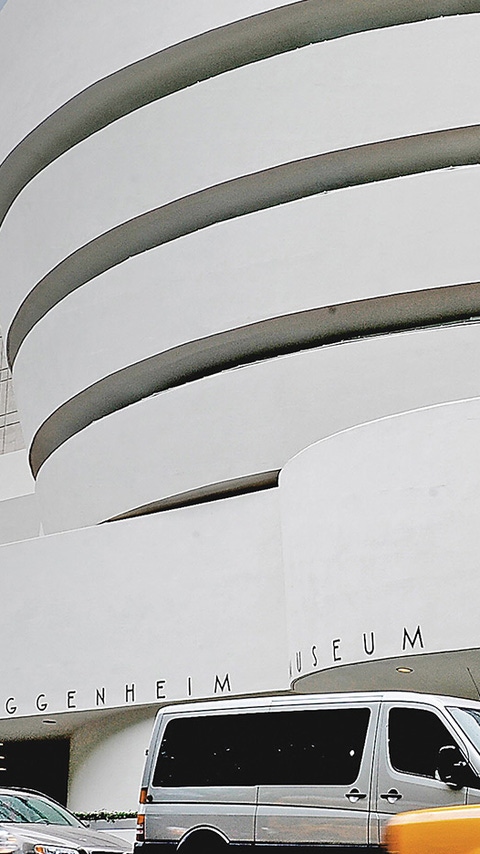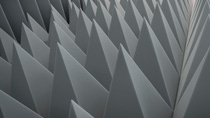Novice in mediji
Silence in the city
New York City is one of the most vibrant cities in the world, but also one of the noisiest. Right at its heart, in the Guggenheim Museum, artist Doug Wheeler created a space of deepest silence. We went to visit.
What is it like to step off the streets of New York City into a place so quiet you can hear your heartbeat? Artist Doug Wheeler’s installation PSAD Synthetic Desert III, conceived in 1971 but first realized only recently at New York’s Solomon R. Guggenheim Museum, transported visitors from the roar of city life into a space of profound silence.
Designed to manipulate sound, light and space in a “semi-anechoic chamber,” the work suppressed all but the lowest levels of ambient sound. Wheeler compared the visual and acoustic impression of Synthetic Desert to his own experience in the deserts of northern Arizona, where near silent conditions profoundly influence the visual sensation of distance. Silence as we know it measures at 30 decibels; PSAD Synthetic Desert III measured in the range of 5–10 decibels – so quiet it was possible for visitors to hear their own heartbeat. What was it like to experience this?
To reach the installation, it was necessary to ascend to the topmost gallery of the spiraling Guggenheim Museum. Once there, we waited our turn at the unassuming entrance. The mood was subdued and rather reverent in the little alcove. A museum attendant made the rules clear: no electronic devices, keep movement to a minimum and no talking or whispering. In groups of just five at a time, we were conducted through the series of sound-proofing antechambers that separated the rest of the museum from the installation space.
From city buzz to desert silence
The room itself was large and subtly lit by concealed neon tubes. A viewing platform extended from a carpeted walkway along the back wall. The effect was like being on a high ledge or at the mouth of a cave, looking off into the distance. The pale ceiling was domed, without edges or corners, reminiscent of an expansive sky. The floor, back wall and parts of the sides and ceiling were covered with hundreds of melamine foam pyramids and wedges made of Basotect® melamine foam, a sound absorbing material from BASF. The installation made use not only of Basotect’s sound-absorbing qualities but also of its versatility. “Basotect can be cut into any shape, coated in any color or wrapped in certain textiles for different textures, providing practically unlimited design options,” says Doyle Robertson, Basotect Sales Manager for BASF in North America.
As the world becomes noisier and busier, creating quieter places is important.”
In PSAD Synthetic Desert III, the lighting combined with the geometry of the pyramids to create striking negative spaces and shadows that called to mind trees and mountains, or even people in a crowd. The angles were uniform and perfect. It felt like a vast open space, rather than a medium-sized room in a building in New York City.
Places of silence
Even in today’s noisy world, there are still places that offer true peace and quiet.
- Eisriesenwelt Ice Caves, AustriaAt a length of more than 40 kilometers, this frosty labyrinth may be the world’s largest ice cave. In the eerie silence, dramatic ice formations appear like giant beings.
- Makgadikgadi Pans National Park, BotswanaThe dry savanna land of the Kalahari Desert surrounds this game reserve. One of the largest salt flats, the only the sound heard during the dry season is the wind.
- Dhamma Giri – Vipassana International Academy, Igatpuri, IndiaAll the students at this meditation center observe “noble silence” – silence of body, speech and mind. The Vipassana style of mediation is more than 2,500 years old.
Once inside, there were the initial muted sounds of shoes on carpeting. The small group spread out and quickly sat down. Then it was quiet. The only sounds were the small noises of our own breathing and swallowing. We became acutely aware of ourselves in space and in relation to others in the room.
The initial impulse to understand the construction slowly waned as we allowed the rational part of the mind to quieten. With distractions from the outside world minimized, the installation was an invitation to focus purely on the sensory. Some visitors lay down. It was very peaceful.
A benefit for body and mind
Being still and quiet allows the chance to reconnect with oneself, with others and one’s place in the world – an increasingly rare phenomenon in today’s world, yet vital for our well-being. “As the world becomes noisier and busier, creating quieter places is important,” says Joerg Hutmacher, CEO of pinta acoustic, the company that cut the Basotect pyramids for the installation. “People perform better in an environment that is visually and acoustically comfortable.”
After what seemed like a very short time, the guard said 30 minutes had passed. We got up and, a little unsteady on our feet, went back through the sound locks and into the museum. It took a while before anyone said anything. Perhaps we didn’t want to break the spell. By the time we reached the lowest level of the Guggenheim’s spiraling galleries, equilibrium was returned.
New York City in July is an amazing feast for all the senses. It was gloriously hot and humid, crowded, noisy, smelly and ever so colorful. Holding a little bit of quiet in our minds, we rejoined the world.
Find out more about these places of silence
- More about the exhibition “PSAD Synthetic Dessert III” (now finished)



